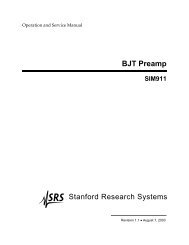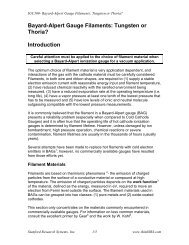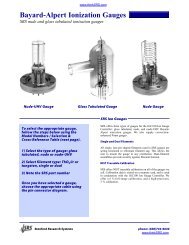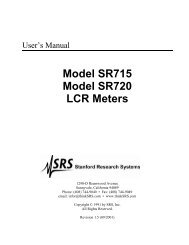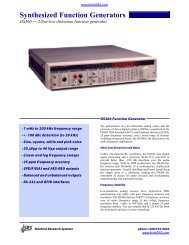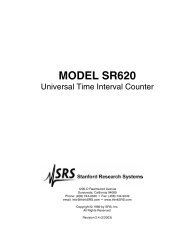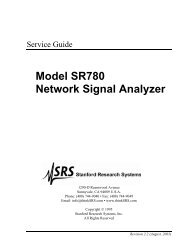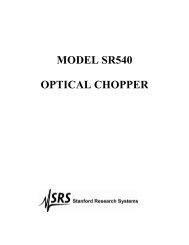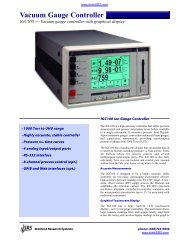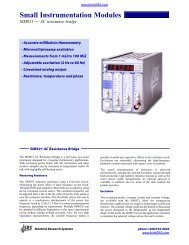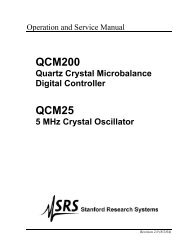Hot vs. Cold Ionization Gauges: Which One is Best for Me?
Hot vs. Cold Ionization Gauges: Which One is Best for Me?
Hot vs. Cold Ionization Gauges: Which One is Best for Me?
You also want an ePaper? Increase the reach of your titles
YUMPU automatically turns print PDFs into web optimized ePapers that Google loves.
4<strong>Hot</strong> <strong>vs</strong>. <strong>Cold</strong> <strong>Ionization</strong> <strong>Gauges</strong><strong>Hot</strong>-Cathode <strong>Gauges</strong> (HCG)The majority of commercially available HCGs are of the Bayard-Alpert design and arecompatible with the IGC100 controller.A Bayard-Alpert gauge (BAG) boils electrons from a hot filament and accelerates themtoward a cylindrical grid cage. As the electrons traverse the space enclosed by the grid,which <strong>is</strong> fully open to the vacuum chamber, they collide with gas molecules ionizingsome of them. A fine wire located at the center of the ionization volume collects theresulting cations producing a current proportional to the gas density at the gauge. Atconstant temperature, the collector current <strong>is</strong> linearly related to the gas pressure.The useful operating range of a conventional BAG extends between 10 -3 and 10 -10 Torr,corresponding to an impressive seven decades of dynamic range. Special gauge designsare available to extend the lower limit to 10 -11 Torr <strong>for</strong> UHV applications, or the upperend to 10 -1 Torr <strong>for</strong> process applications.The strict linear dependence of collector current on pressure <strong>is</strong> one of the most importantadvantages of HCGs over the competing ionization technology. It <strong>is</strong> generally possible toapproximate the 'collector current <strong>vs</strong>. pressure' response of a BAG to a straight line andcalculate pressures from a single linear proportionality factor (i.e. sensitivity factor)stored in the gauge controller. A sensitivity factor calibrated at mid-range, can be used <strong>for</strong>accurate and reproducible pressure measurements between 10 -9 and 10 -4 Torr. Deviationsfrom linearity typically amount to less than ±25% over the entire useful dynamic range ofthe gauge, with the biggest deviations taking place at the operating limits.BAGs are generally considered to be more accurate, stable and reproducible than CCGs.Under controlled vacuum conditions, the reproducibility of a BAG calibration can be asgood as 2% through a year of uninterrupted operation. Repeatability <strong>is</strong> 1-2%, limited byuncontrollable random sensitivity variations. However, not all BAGs are created equaland gauge-to-gauge and long-term stability variations are to be expected fromcommercial devices used in 'real' systems. <strong>Me</strong>asurement accuracies better than ±50%require calibration of the individual gauge response. High accuracy gauge designs haverecently become available that guarantee better than 3% measurement accuracy followingcalibration against NIST standards. Calibrated, high-accuracy BAGs combined with highquality controllers, such as the IGC100, are commonly used as transfer standards in highvacuum gauge calibration laboratories.BAG readings are gas dependent due to varying ionization efficiencies, and are usuallycalibrated <strong>for</strong> nitrogen gas (argon <strong>is</strong> also a popular choice in semiconductor processing).Gas correction factors, readily available from the vacuum literature, can be used tocorrect the gauge readings <strong>for</strong> other gases.Any BAG, depending on its past h<strong>is</strong>tory of operation and the prec<strong>is</strong>e atmosphere in thevacuum system, can act as either a source (outgassing) or sink (pumping) of gas. Itsoperation can cause significant changes to the gas composition in the system. The relativeimportance of these effects depends upon the overall vacuum system character<strong>is</strong>tics andoperating conditions. For example, changes in pressure and gas composition due topumping or outgassing will be relatively more significant in a small UHV system withlow pumping speed, than in a large industrial vacuum chamber with large diffusionIGC100 Ion Gauge Controller



